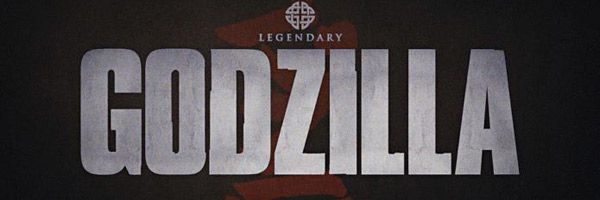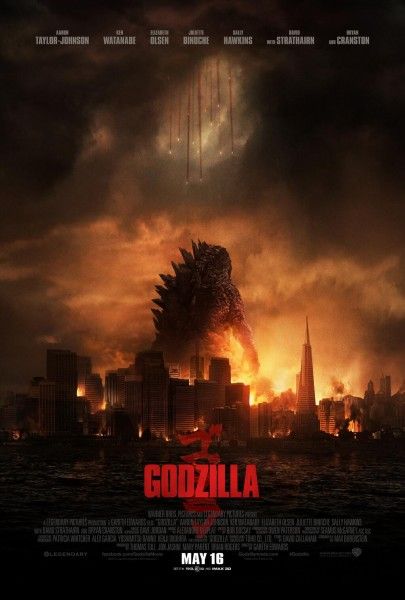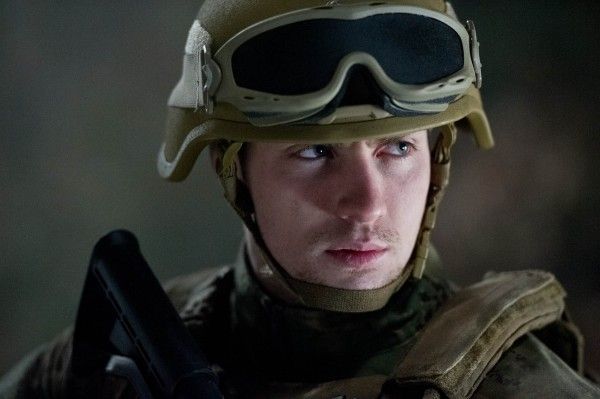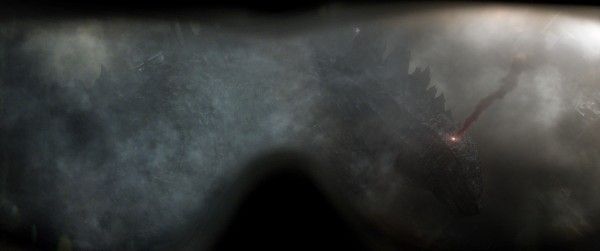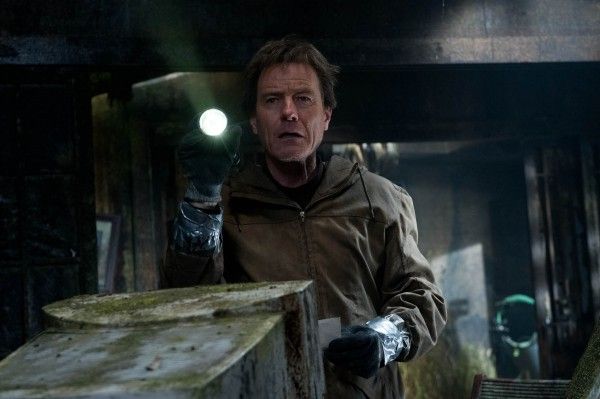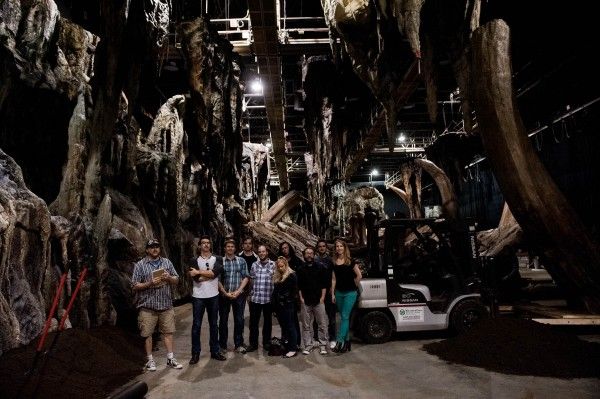A young man in a radiation suit surveys the ruins of a dilapidated Japanese house. Insects crawl along the floors and walls. Nature has overtaken the abandoned home. The young man sweeps his flashlight across the dimly lit room, but what he’s trying to find is unknown. His father is also combing the old house; hoping to find a crucial piece of information that could help them, and in turn, possibly help humanity. It’s a quiet scene, but the stakes are monstrous.
Hit the jump to read about my visit to the set of Warner Bros. and Legendary Pictures’ Godzilla.
It’s June 15, 2013, and I, along with a handful of other entertainment journalists, arrive on the set in Vancouver where a truck full of fake dead bodies is waiting by the entrance. Whether it just happened to be there or if it was planted there in anticipation of our arrival, it’s a good sign. Every movie, even if it’s a lighthearted romantic comedy, should have a truck full of fake dead bodies by the entrance (especially if it’s a lighthearted romantic comedy). With the assumption that these unlucky fake souls were caught in the monster’s wake, we enter the building and head up to the art department where we meet production designer Owen Paterson (The Matrix Trilogy).
Informally referred to as “the war room”, the production department lays out the entire movie in the form of concept art. As far as we can tell, it’s not in chronological order, but pretty much every scene in the movie is up on this wall. “It’s kind of a road movie,” Paterson says. The film will take the characters across Japan, the Philippines, Hawaii, the Midwest, and San Francisco. There are 95 sets in the film, and a quick sweep across the concept art shows aircraft carriers, nuclear reactors, cities pre- and post-devastation, and the little, broken-down Japanese home we’ll be visiting later on. There’s also something called the “M.U.T.O. Base”. The events of the movie will span from 1954 (the year the original Godzilla was released) to 1999 to the present day (2014).
Paterson along with executive producer Alex Garcia (Jack the Giant Slayer) and producer Mary Parent (Pacific Rim) explain that director Gareth Edwards (Monsters) is going to a “documentary-esque” look for his movie. Much like Monsters, the idea is to ground the monster in a realistic world, and try to play out what that event would actually look like as opposed to Legendary’s Pacific Rim, which is more about world-building and a sci-fi fantasy concept. Parent explains that Godzilla is “grounded, not grim” and the violence is real, but not gratuitous (i.e. a PG-13 blockbuster). Paterson also notes that one of the key influences on Godzilla is, surprisingly, Close Encounters of the Third Kind. However, we’re also told that the emotional core is about Navy Lieutenant Ford Brody (Aaron Johnson) and his scientist father Joe (Bryan Cranston) trying to repair their estranged relationship. The larger theme will relate to the old chestnut of man-vs-nature, a theme that was somewhat explored in the original Godzilla, but with more of an emphasis on how that related to nuclear war.
The specifics of the man-vs-nature struggle in Godzilla are left vague, and that vagueness will permeate our visit. By the time you read this set visit, you may have already seen one or two trailers along with a full synopsis. But in June 2013, the marketing campaign hasn’t reached the point of knowing what should and shouldn’t be released to the public. So while they can set a group of journalists loose in the art department, everyone is being careful about what they’ll tell us for fear of spoiling the plot.
We’re then left to try and piece together what concept art we can, and also appreciate the work that Edwards, Paterson, and the production crew have done in researching and building the world of Godzilla. There are nice little details such as a Combat Information Center (CIC) that doesn’t look ultra-futuristic, but like something you’d see if you actually went inside an aircraft carrier. Another impressive touch is dressing up a real-world shantytown like Finn Slough in Richmond, British Columbia, and turning it into a drowned Japanese town where Joe and Ford go looking for answers in their old home.
But before we get to that search, we’re still missing the monster in the room. There are a few pieces of Godzilla concept art on the wall, but not as much as you’d expect. We may be in the war room, but we’re told that the designs for the monsters (the plural being emphasized to let us know that Godzilla will be throwing down with other gargantuan beasts) are still preliminary. However, when it comes to Godzilla, this is the guy. Based on the concept art, Edwards and his team truly understand the look of the creature with his short face and distinctive build. If Edwards and his team succeeds in bringing this concept art to life, then what we’re going to see will be true to form, but acceptably updated to what modern technology can accomplish. We also see the distinctive atomic breath (portrayed in the concept art as a blue beam of light), and Paterson says Godzilla stands at about 400 feet tall. And we’re about get a sense of his scale.
We head over to see some pre-visualization (pre-viz). For those who don’t know, pre-viz is like computer-animated storyboards. My first introduction to the technology was in the special features for The Fellowship of the Ring, and I remember crude little geometric shapes running down a crumbling staircase. As I saw from the pre-viz on Godzilla, the technology has come a long way. It doesn’t just take us through the motions of the set piece, but the overall tone and feel. And that overall tone is very promising.
Before showing us two pre-visualized scenes, the group was shown the Comic-Con 2012 announcement trailer for those who hadn’t seen it. I was in Hall H when it brought the house down, and it’s no less exciting almost a year later. You can click here to read Adam’s brief write-up of the footage when we saw it at Comic-Con. After the Comic-Con teaser (which Edwards put together) wows the group, we’re then shown a couple of pre-vized scenes.
First up is a particularly impressive piece that I hope will be on screen exactly as we saw it. Plot-wise, it’s very simple: a group of military paratroopers are doing a “HALO Jump” (high altitude, low opening) into a city that is being torn up by a monster. But the way it’s executed is stunning. After building tension with the soldiers in the plane getting ready for the jump, the paratroopers leap out of the aircraft, and then activate red smoke to show the trajectory of their fall [If you've seen the trailer, you've seen the finished version of the scene's beginning]. Using an operatic temp track, the HALO jump is basically done in real time, and the way the scene is “shot”, the red smoke makes it look like the sky is bleeding. As the troopers get closer and closer to their target, lightning begins to flash. They get even closer and the lightning reveals a silhouette of a monster destroying the city. It’s an effective scene that requires a little patience of the audience, but the visuals are striking, and the payoff is exciting and dramatic.
The other scene is more like a horror film. A group of soldiers is on a bridge at night when a blast of wind and dust knocks out the lighting on their equipment. They activate glowsticks and go to check out the source of the blast. They move through the tunnel, and out on the other side they see the flaming wreckage of military planes and tanks quietly floating down the river. Some of the soldiers go to the ground to investigate while others remain on top of the bridge. As one of the ground soldiers looks around, a monster (not Godzilla) rises up out of the forest, dwarfing the tiny humans. The soldiers are on the bridge can only watch in horror as there’s nowhere to run, and as if things weren’t bad enough, a flaming train comes hurdling down the track. And to complete the “wrong place and the wrong time” milieu, the monster smashes the bridge and then eats the flaming train. I would like to think that the last thought that went through the mind of the pre-viz soldier was “I did not sign up for this shit.”
After the pre-viz, we wrap up with the producers with just a couple of quick questions based on what we just saw. Since we now know there are other monsters, the producers confirm that those monsters will have unique abilities similar to how Godzilla has atomic breath. We are also told that Edwards and cinematographer Seamus McGarvey (The Avengers) are over-seeing the 3D post-conversion.
We then head over to the set where the air is hot and thick with the haze and smog created by smoke machines. We take a seat near a monitor to watch Taylor-Johnson go through the motions of walking through the ruined Japanese house where he, Joe, and the rest of their family used to live. The set it accurate to 1999 in terms of props littering the set. For example, that there’s a dusty, broken, but still colorful iMac in the corner. In between takes, a bug wrangler meticulously tries to get a live cockroach to crawl on a framed photo on the wall. The diva bug isn’t having it.
In between takes, Cranston comes over to talk to us for the first of three times. Over the course of our three informative and very funny conversation, Cranston talked about the action scenes, working with Edwards, being a fan of the character, and more. Click here to read the full interview.
Cranston then heads back to the set, and the scene has progressed a little further. It can be a bit tiring to watch the same 5-10 seconds of action repeated 8 or 9 times, but it’s cool when you start seeing how it comes together. Ford is walking through the ruined home, and on the ground we see scattered toys on the ground. The toys are soldiers, tanks, and dinosaurs. Ford picks up a toy soldier and looks at it; there’s a wistful look on his face. Suddently, Joe rushes into the room. “What did you do?” he cries at Ford. “I didn’t do anything!” Ford responds. Then a fan is turned on outside to create the effect of a heavy wind sweeping in. “Oh, shit,” says Joe. Then the two rush outside as the camera pulls in on an old Japanese poster depicting monsters fighting.
While it’s a relatively simple scene, it wasn’t played this way every single time. Cranston only said, “Oh, shit,” in one take. Sometimes, the wind kicks in after Ford picks up the action figure, and other times it kicks in after he says, “I didn’t do anything!” It’s interesting to see how small things like deciding when the wind blows in can change the dramatic impact of a scene.
During another break in filming, Taylor-Johnson comes over to talk to us. With his hair cut short and added muscle, he looks far more mature than in his previous roles. As Taylor-Johnson explains to us, Ford is a leader, not the nervous, geeky teenager from Kick-Ass. During our conversation, Taylor-Johnson talked about his preparation for the role, working with Edwards and Cranston, the scale of the picture, and more. Click here for the full interview.
We then walked over to talk to Edwards. When asked what it was like to go from Monsters, which was estimated to cost around $500,000, to the blockbuster scale of Godzilla, he replied, “It’s a bit like going from riding a bike to piloting a 747. You still know left and right, and as long as you reach your destination..." During our conversation, we talked about the theme of the picture, Godzilla's personality, the involvement of Toho (the Japanese company that owns the character), and more. Click here for the full interview. He also told us that the movie will have Easter eggs, and there’s even one in the scene they’re filming right now (we saw what it was, and it’s pretty clever, but I won’t spoil it).
After lunch, we head to a set that’s under construction and will likely be used on Monday since outdoor shooting will be nixed due to rain. If you’re going to spend a day filming indoors, it’s not bad to spend it inside a monster’s ribcage. The daunting set is a cavern where stalactites overhang the chest cavity of a long-dead, gigantic creature. Looking at it, I’m trying to figure out how this body part, and apparently only this body part, got into such a tight space, but we’re told that it’s possible more stuff will be edited in via green screen. In any case, the practical set is still impressive and just one of the monster’s vertebrae measures approximately 5.5 feet. We don’t know the exact size of the full set, but we’re told it cost more to make this one piece—which will only be used for one day of filming—than it cost to make Monsters. A 747 indeed.
We headed over to another stage to see some second-unit filming and to speak to visual effects supervisor Jim Rygiel (The Lord of the Rings Trilogy). Before we spoke to Rygiel, we got to see a group of extras on top of a pile of smoking rubble and surrounded by green screen. The group includes civilians, firemen, and soldiers who are helping to move rocks and help people up from the destruction. Looking just a little to our right, we can see a completely different set. It’s the exterior wall of an aircraft carrier with a rack of torpedos in front. Unfortunately, we don’t get to see that set used for anything, and so we turn back to watch the extras go through the motions of recovering from a monster attack. At one point, they’re directed to look into the distance and be confused by the specter of something very big waking up.
Granted, this is visit to the set of Godzilla and no Godzilla. “Such a diva,” Cranston quipped at one point. It’s a tough position for any production when your big star is too big to see or even be somewhat realized at this stage in the production. As I said earlier, the people we spoke to were somewhat guarded, so I can’t tell you what “M.U.T.O.s” are other than a military acronym (possibly a name for the other monsters Godzilla fights?) or how they’ll even announce Godzilla’s name in the picture. Will it be offhanded like “Superman” in Man of Steel, or will it be a big and bold pronouncement as someone looks to the sky and shouts, “It’s Godzilla!”
Edwards may still be deciding how he wants to announce the King of the Monsters, but he has no doubt about his intent to blend the thematic resonance of the 1954 original with classic kaiju battles of the later movies. And looking at the concept art of the classic creature looking down over San Francisco, rampaging onwards, I can say without hesitation, “It’s Godzilla.”
Godzilla opens in 2D, 3D, and IMAX 3D on May 16th.
Click on the corresponding links before for more of my Godzilla set visit coverage:
- Director Gareth Edwards Talks Making the Leap from an Indie to a Blockbuster, Man-vs-Nature, Easter Eggs, and More on the Set of GODZILLA
- Aaron Taylor-Johnson Talks the Tone of the Picture, the Raw Energy During Filming, and More on the Set of GODZILLA
- Bryan Cranston Talks about His Thoughts on the Script, the Appeal of a Character-Driven Blockbuster, and More on the Set of GODZILLA
- Legendary Pictures CEO and Producer Thomas Tull Talks GODZILLA, His Love for the Character, Handling Comic-Con, PACIFIC RIM 2, and More

